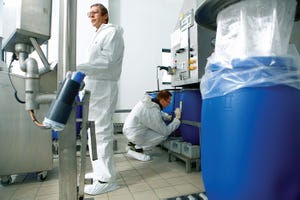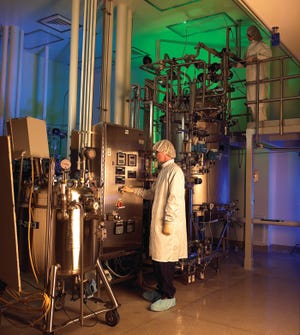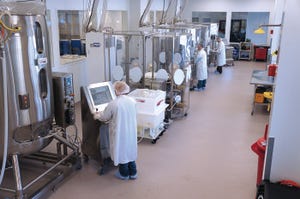Welcome to our first full issue of summaries from our 2015 BioProcess Theater programs. This is a bit of a different concept and format from our regular issues and supplements, so a few words of explanation are necessary.
At the Interphex conference (21–22 April 2015) and the Biotechnology Industry Organization’s annual convention (16–18 June 2015), BPI again organized and conducted presentation programs within the exhibit halls. We have been holding the BPI Theater @ BIO for eight years now, and the BPI Theater @ Interphex was in its second year for 2015. Last year, we published special reports comprising brief summaries of the theater presentations, guiding our readers to full audio recordings on our website (www.bioprocessintl.com/category/ multimedia).
This year, we combined the two programs and used our supplement format to lengthen the summaries, thus providing you with more detail. The URLs provided will take you to full audio presentations on our site that include the original slide presentations ...
Matt Feldman (senior manager of strategic communications, Aeras) 10:00–10:25 am
Vaccines, Global Health, and the Future of Fighting Tuberculosis
Aeras is a nonprofit biotechnology company located in Rockville, MD, with other locations in Beijing, China, and in Cape Town, South Africa. Its mission is to advance tuberculosis (TB) vaccines worldwide. The fully integrated biotech company has in-house capabilities in finance, portfolio management, and manufacturing, taking products from preclinical through phase 2b clinical trials. Aeras is governed by a board of directors, external and internal advisory groups, and a leadership team with experience in public- and private-sector vaccine development — all in all, employing about 160 people with an annual budget of about $55 million. Financing primarily comes from donors such as the Gates Foundation and from governments around the world.
Feldman began with a short history of infectious diseases and how they have affected civilizations over thousands of years. He...

 +1
+1Bill Hartzel (director of strategic execution for advanced delivery technologies, Catalent Pharma) 1:30–1:55 pm
Reducing the Risk Associated with the Filling of Biologics with Advanced Aseptic Processing
Hartzel discussed leveraging “blow–fill–seal” (BFS) aseptic processing technology to reduce risks associated with biologics fill and finish. A number of drug recalls have been associated with microbial and particulate contamination of glass vials, problems that could be solved using BFS. Automation eliminates human intervention at this critical stage, driving out associated risks. Hartzel said that BFS plastic (polypropylene) containers have a more inert surface than glass.
In BFS, resin pellets run through an extruder, which forms the containers. They are filled with drug product, then automatically stoppered and sealed. The full, closed process takes 15 seconds in a class A environment. Hartzel’s company fills 8–50 units in each 15-second cycle depending on container design. Containers are open for onl...

 +2
+2Tony Hitchcock (technical director, Cobra Biologics) 1:30–1:55 pm
The Expanding DNA and Gene Therapy Market
The gene therapy market has fluctuated dramatically over the past 20 years. But Hitchcock noted that over the past three years there has been a huge emergence of successful clinical outputs of gene therapy, with a large number of IPOs and significant funding. Even more interesting is the number of large pharmaceutical companies bringing gene therapy into their portfolios. Hitchcock pointed out that it is a varied market in terms of therapeutic areas — going beyond the original gene replacement indications into cancer, infection, neurology, oncology, and cerebral folate deficiency (CFD). One product is licensed in Liberia, but a number of other projects are coming out of phase 1 and some are approaching phase 3.
Market Projections:
Hitchcock said that some analysts project a 20-fold growth in the market over the next 10 years. Eighty percent of that market is expected to be in oncology. Not counted ...

 +3
+3SANOFI AVENTIS (WWW.SANOFI.COM)
On Tuesday, 21 April 2015, Eric S. Langer (managing partner at BioPlan Associates) chaired a midday roundtable titled, “Deciding on Single-Use vs. Stainless Steel Bioprocessing Strategy: What Do CMOs Know That Biopharmas Don’t?” Langer brought together these industry experts to discuss choosing between stainless steel and single-use technologies (SUTs) for different applications:
William Hartzel (Catalent Pharma Solutions)
Hartzel emphasized defining goals and objectives first off, acknowledging that those do vary between drug companies and service providers. Each company must examine its philosophy and business models, then align its manufacturing strategies with them. A main focus for contract manufacturing organizations (CMOs) is providing speed and flexibility in multiproduct facilities for their customers. Hartzel pointed to cell- expression technology as an example. He described Catalent’s transition from working with transgenic cattle to cell culture in stainless ste...
Andrew Lidums (NA business development manager, Parker domnick hunter) 2:30–2:55 pm
Implementing a Risk-Management–Based Approach to the Prevention of Mycoplasma Contaminations
Lidums began with a recent report from Genentech, where a 150-µm long
Leptospira
organism from a drainage ditch outside the facility managed to penetrate 0.1-µm filters. The company solved this problem by lowering the temperature of the filtration operation, which made the bacteria more rigid and kept them from getting through. Clearly, however, contaminations happen even at large facilities.
Mycoplasma are the smallest class of bacteria, varying in size and shape from 0.2 µm and larger. Lacking a cell wall, they can deform and squeeze through pores, making them difficult to remove with typical 0.2-µm sterilizing-grade filters. Slow-growing and difficult to detect, mycoplasma often come from agriculturally derived components in cell culture media, and some species are associated with humans, so operators can bring them into steri...

 +4
+4BAXTER HEALTHCARE (WWW.BAXTER.COM)
On Wednesday, 22 April 2015, Susan Dexter (principal consultant at Latham BioPharm Group) chaired a midday roundtable titled, “Fill and Finish Manufacturing Strategies: Better or Just New?” She brought together three industry experts to provide mixed perspectives:
Susan Dexter, Latham BioPharm
Fill–finish (FF) is the last manufacturing step and the most critical to maintaining product quality before patient use. That’s an important aspect of what regulatory authorities assess when they inspect FF facilities. Washing, depyrogenating, and filling– capping processes are complicated systems involving many moving parts. The US Food and Drug Administration (FDA) is interested in novel technologies and new ways of doing things to “derisk” the GMP envelope around these processes. Disposable technologies, which have derisked the GMP validation space around bioprocessing of drug substances, may be able to do the same for drug products.
Joe Figlio (BARDA)
Figlio monitors and review...
Ray Price (senior director of business development, DiscoveRx) 3:30–3:55 pm
Advances in Research Tools to Accelerate Drug Development
Price introduced the BioSeek drug-discovery platform with examples. The technology is built on three pillars: primary human cells; models that use growth factors or cytokines to model a disease environment and then predict how drugs change biomarker responses in those systems; and comparisons of generated profiles with a reference database of more than 4,000 compounds. DiscoveRx uses that database and informatics tools to predict clinical outcomes.
To be as physiologically relevant as possible, the company generates cultures of endothelial cells that produce factors and peripheral blood mononuclear cells (PBMCs) and that respond to those factors. These human primary cells mimic what happens in vivo, providing for disease-relevant assays. Often this is the first time that a client’s molecule has been tested in a primary cell model. Designed to be quantitative, robust, and re...

 +4
+4FUJIFILM DIOSYNTH BIOTECHNOLOGIES (WWW.FUJIFILMDIOSYNTH.COM)
On Wednesday 17 June 2015, Patricia Seymour (senior consultant at BioProcess Technology Consultants) chaired a midday roundtable titled, “Managing the Contract Relationship.” She brought together a panel of four experts with different perspectives (contract manufacturing, cell and protein therapies, and legal negotiations):
Panel Introductions
Koen Hellendoorn:
Based in the United Kingdom and the United States, FujiFilm DioSynth Biotechnologies is a contract manufacturing organization (CMO) with about 15 years’ experience in recombinant proteins. More than 1,000 employees work with clients both large and small on process development and good manufacturing practice (GMP) operations. The company recently acquired a Texas CMO (Kalon Biotherapeutics) that focuses on viral vaccines and cell therapies. Hellendoorn spoke of how a CMO can build a strong relationship with customers through solid contracts that defend both parties when something goes wro...
XCELLEREX (WWW.GELIFESCIENCES.COM)
On Tuesday, 16 June 2015, Thomas C. Ransohoff (vice president of BioProcess Technology Consultants) chaired a midday roundtable titled, “Stretching for the Trifecta: Innovative Strategies for Speeding Development, Lowering Costs, and Enhancing Quality.” He brought together a panel of four industry experts:
Thomas C. Ransohoff (BioProcess Technology Consultants)
Conventional wisdom says that biopharmaceutical companies must choose only two of these three goals: high quality, speedy development/ manufacturing, and low cost. But increasingly, Ransohoff pointed out, the industry is being asked to meet all three goals simultaneously. Two main drivers are forcing companies to shorten timelines: new regulatory pathways (e.g., biosimilar pathways, breakthrough therapy designation) and competition, especially in the most promising discovery areas (e.g., oncology). Meanwhile, increasing price pressures are accompanying the emergence of biosimilar competition — driving the biologic...
COOK PHARMICA (WWW.COOKPHARMICA.COM)
On Thursday, 18 June 2015, Gil Roth (founder and president of the Pharma & Biopharma Outsourcing Association, PBOA) chaired a midday roundtable titled, “CDMO Challenges and Opportunities.” He brought together a panel of four industry experts:
Points of View
The Pharma and Biopharma Outsourcing Association (www. pharma-bio.org) was founded in 2014 to represent contract manufacturing organizations (CMOs) and contract development and manufacturing organizations (CDMOs). A number of member companies were represented on the panel.
Thorpe’s company, Afton Scientific, is a small-scale contract manufacturer of sterile injectables and presterilized ready-to-fill (RtF) vials based in Charlottesville, VA. The company is in the process of adding a second facility.
Arora heads the CMO business for Jubilant Pharma (an Indian conglomerate) in Spokane, WA, and Montreal, Canada. The company fills sterile and nonsterile vials, creams, lotions, and ophthalmics as well as develops solid ...










